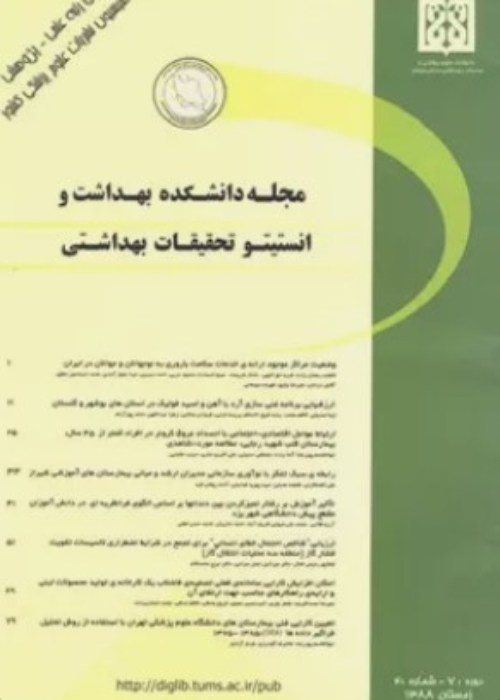THE TREND OF MALARIA DRUG RESISTANCE IN IRAN DURING 1983-2001
Author(s):
Abstract:
One of the main problems in malaria control is the resistance of Plasmodium falciparum to chloroquine and some other antimalarial drugs. This resistance is now quite common in most regions where falciparum malaria is endemic. Between 1968 and 1976, two in-vivo studies were carried out in endemic areas in the south of Iran and they showed P. falciparum to be chloroquine-sensitive. In 1983, the Department of Protozoology in the School of Public Health undertook in vivo and in vitro studies on the response of P. falciparum to chloroquine and other antimalarials. In the Iran-Shahr region a few cases of in vivo resistance to chloroquine were found in 1983, and the rate of resistance was 5.7% at RI level. Between 1994 and 1996, resistance in this region gradually increased to 51.2% at RI, RII and RIII. In Bandar-Abbas and Kahnoudj areas, prevalence of chloroquine-resistant P. falciparum infection was 32.5% at RI and RII from 1986 to 1987; it increased to 64.8% at RI,RII and RIII levels from1994 to1996 and then altered between 68% and 84% at RI and RII levels in the 1997-2001 period. 88 chloroquine-resistant patients were treated with standard doses of sulfadoxine-pyrimethmine (Fansidar) alone or in combination with amodiaquine and then examined with 28-day in-vivo tests. In 13.6% of them resistance was observed at RI and RII levels. In micro in-vitro tests, using WHO standard kits, the rates of resistance of P. falciparum to chloroquine, amodiaquine, sulfadoxine-pyrimethamine, mefloquine and quinine were 33.4%, 15.2%, 17.9%, 2.2% and 0.0% in 281, 72, 39, 44 and 72 cases respectively. As mefloquine has never been used in the studied areas, the sporadic cases of in-vitro mefloquine resistance may be considered as cases of innate and/or imported resistance. Primary resistant casese was seen mostly among Afghan and Pakistani immigrants/passengers. Hence these individuals are likely to have introduced chloroquine–resistant malaria into this country. The in vivo response of Plasmodium vivax to chloroquine was also studied in 827 patients was also studied in the endemic areas of the South-East between 1995 and 2001. The mean parasite clearance time (MPCT) was 2.78 and no resistant cases were found. Most cases in these studies had been referred by the local Malaria Control Laboratories to the research facilities at Health Training and Research Centers in Bandar-Abbas and Iran-Shahr. Some had received chloroquine, and those with a good response had not been referred. Therefore, the high rates of chloroquine resistance found in these studies probably do not reflect overall resistance rates at population level. To determine true resistance levels in these areas, all eligible patients must undergo WHO’s simplified in-vivo tests performed by trained malaria microscopists or laboratory technicians.
Language:
Persian
Published:
Scientific Journal of School of Public Health and Institute of Public Health Research, Volume:2 Issue: 3, 2004
Pages:
83 to 94
magiran.com/p481026
دانلود و مطالعه متن این مقاله با یکی از روشهای زیر امکان پذیر است:
اشتراک شخصی
با عضویت و پرداخت آنلاین حق اشتراک یکساله به مبلغ 1,390,000ريال میتوانید 70 عنوان مطلب دانلود کنید!
اشتراک سازمانی
به کتابخانه دانشگاه یا محل کار خود پیشنهاد کنید تا اشتراک سازمانی این پایگاه را برای دسترسی نامحدود همه کاربران به متن مطالب تهیه نمایند!
توجه!
- حق عضویت دریافتی صرف حمایت از نشریات عضو و نگهداری، تکمیل و توسعه مگیران میشود.
- پرداخت حق اشتراک و دانلود مقالات اجازه بازنشر آن در سایر رسانههای چاپی و دیجیتال را به کاربر نمیدهد.
In order to view content subscription is required
Personal subscription
Subscribe magiran.com for 70 € euros via PayPal and download 70 articles during a year.
Organization subscription
Please contact us to subscribe your university or library for unlimited access!


